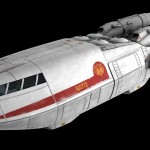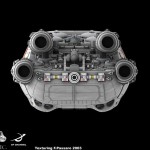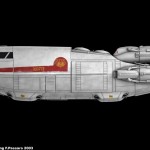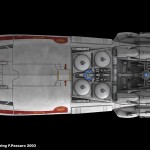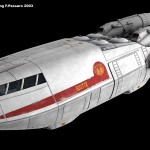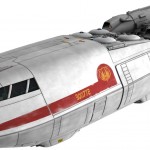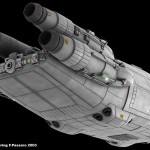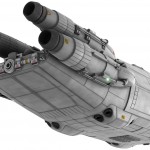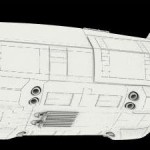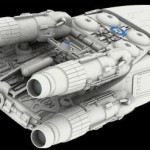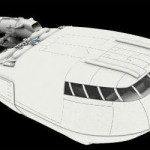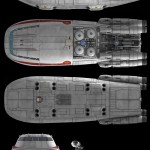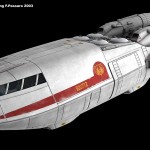December 20, 2008
Designed by famed modelers Charles Adams, Mark Dickson, Don Bergren and Fabio, here are a few CG renders of the Shuttle from Battlestar Galactica – The New Series. Below the photos is the full background of how this shuttle came to be… as told by Mr. Charles Adams!
October 6, 2010
Battlestar Galactica Mk II Shuttle Design by Charles Adams
as seen on GALACTICA.TV
| Written by Charles Adams | |
| Wednesday, 06 October 2010 | |
In the Spring of 2003 I was given the honor of designing a major spaceship for a big-budget science fiction television production — Battlestar Galactica. Although I was a commercial artist and had done professional illustration and design for over 10 years, this was my first time doing this kind of work. It was totally different from anything I had done in the past, mainly because of the collaborative nature of the job. For most films the Art Department is in charge of designing the space ships. One or more illustrators work under the guidance of an Art Director who supervises the design process. Once approved, the resulting design sketches are turned over to the model builders. The designs evolve all along the way as different people each have their own input, so the finished ship is therefore the result of a collaborative team effort. The circumstances in this case were very similar. But what was unusual was that much of the space ship design was left to the visual effects people, in this case Zoic Studios. If this had not happened, I probably would never have had the opportunity to work on this project. In the beginning… The script called for a shuttle to appear in the opening scene at Armistice Station. This was conceived to include a transition sequence which would portray the passage of time using the spaceships to indicate the era being depicted. The effects artists at Zoic hoped to use the original shuttle design from the 1978 television series to show what occurred in the past and a new, updated ship which would set the stage for the action taking place in the “present.” Unfortunately, this sequence got shortened and the new shuttle design ended up getting cut altogether from the scene. But Lee Stringer, CG Effects Supervisor at Zoic Studios, realized that an updated shuttle would be one of the central vehicles in the show so he made every effort to use the completed model in as many scenes as possible. I reminisced with Lee about all this recently and here is what he had to say on the subject: (Charles) How did the opportunity come about for the visual effects artists at Zoic to participate in designing the spaceships? Isn’t this a task typically handled by the Art Department? (Lee) Mostly it was handled by the Art Department but with most shows there is far too much to do and the Art Department tends to concentrate on the on-set activities and practical elements. Plus there’s our wish to add more than is required and thus it’s on our heads to design and build. (Charles) You used the original shuttle design in the pilot episode. Why did you feel the need to create an updated shuttle design? (Lee) Originally the opening at the Armistice Station showed the forty years of time passing since the Cylon war, thus at first you see the original shuttle and a clean version of the station and then near the end you would see the newer shuttle and an older version of the station. In order to keep the pace of the show moving this was all cut. But we had already built the old and new shuttles and the old one wasn’t really needed, so we decided to use it for the opening sequence and save the newer shuttle for use on the Galactica. Also having an original series ship be in the very first show of the new mini series was a small link to the past. First Concepts As the Art Director for this particular ship design, Lee had a definite set of guidelines that he wanted followed. Mark Dickson had already done an initial design sketch which was based on the original shuttle from BSG TOS with a modified cockpit area. Lee sent this to me and explained his ideas for what he wanted to do to enhance the concept. What was your original vision for the new shuttle? Simply to take the original series shuttle and make a version that was forty years further on. Who was in charge of the final “look?” I guess that was me as we had no designs from the Art Department, but it was the Visual Effects Supervisor Gary Hutzel’s call in the end. Luckily we think along a similar line of logic so what I was thinking was very much what he had in mind. How did you choose the person who ended up with the job of doing the conceptual design? …I was looking for fans of the original show that also had related professional skills and do what I could to hire them onto the show. When I found out I might have the opportunity to actually do some design work for the new mini-series, I immediately sat down and started sketching out some concepts for different ships just to demonstrate what I could do. I even threw in some designs for ships other than the shuttle. (Heck, you never know when something else might end up getting used…)
Once I got hired and we started working on the shuttle design, I wanted to allow plenty of room to explore different ideas. So, while I developed Lee’s concept I also tried out some other shapes. One of these was an “organic” design with a smooth, rounded hull and four engines in back instead of two. While this was ultimately abandoned, several important design cues from this model made their way into the final concept (most notably the engine configuration).  There were also plenty of concept ideas that did not make “the final cut.” But many of these sketches contained elements of the final design in one form or another:
Lee wanted to maintain the original hull cross section of the “TOS” shuttle so that it was recognizable as being a descendant of the original. But he also wanted a very different look for the cockpit -something more akin to a modern jetliner. After some brainstorming, I finally had a sketch which I felt accomplished many of the goals set out by Lee.
Evolving Design We continued to work on this concept, trying out different variations. The shuttle grew in length and the engines became more prominent. The final design emerged as a blending of my concepts, Lee’s vision, and the TOS shuttle variation originally sketched by Mark Dickson. When I felt the design was nearing a finished stage, I had a chance to finally try something I had been wanting to do for years — build a CG model. Since I was new at this sort of thing and there was not much time, it would have to be something simple and quick. But my primary motivation was to be able to see the design I had created from all angles and tweak it until it was nearly perfect. Normally, for this sort of project I would take the time to build a physical study model or “maquette” in order to see how it actually looked in three dimensions. But a CG model is even better and has the benefit of making it very easy to produce final plan view drawings for the model builders to use as a construction guide. After getting up to speed on how to use my new CG modeling program, I was able to get a decent study model built and rendered. This was submitted to Lee and he sent the renders on to the Visual Effects Supervisor (Gary Hutzel) who gave them his final seal of approval. The conceptual design was complete!
Finishing Touches This would normally be the end of the road for the conceptual artist on a project like this. But I wanted to take things further and enhance the design as much as possible. While I would not able to participate in actually building the final CG model, I could come up with as many of the details as possible to aid those tasked with building the ship in the computer. From the beginning I wanted this to be a practical, believable design and Lee agreed. Each time I presented an idea, it was in the context of a practical “reality” that could be depicted on screen. For example: The shuttle was designed with two levels. The entire main level is one uninterrupted space from the bow to the stern which makes it a capable and efficient cargo transport.
Building the CG “Miniature” Once approved, the final design was turned over to Mark Dickson and Don “Titon” Bergren who brought it to life inside the computer. They actually built the ship in CG and added all of the many surface details. Fabio from Zoic Studios did all of the texturing on the final model. Many people have commented on the clever addition of “kit part” surface details that match those used on the original TOS shuttle. I believe Mark had always wanted to do this, and I had suggested to Lee on more than one occasion that we use actual parts from the original shuttle to detail the new one. He liked the idea as well and that can be seen in the final design. This is far more realistic than the simply applying texture maps and painted surface details which is the way most CG miniatures have traditionally been built. This was yet another example of the dedication on the part of the people behind the scenes who were creating these models. Don had this to say about the process: (Charles) How did the opportunity come about for you to work on this project? (Don) An unfortunate remodeling accident. Mark Dickson began construction of the Mk2 in Lightwave but while doing some home repairs he injured his thumb. After my initial work on other projects for the series I asked Lee if I could take up the challenge of building the Mk2 to it’s conclusion. You also were heavily involved in building the the original shuttle model used in the pilot episode. Can you tell us a little about that project? The TOS shuttle was most definitely a labor of love for two people. Mark Dickson and I spent months researching the shuttle and I can’t tell you how many rebuilds and refinements it went through. We built the first version but in doing some fine measuring the body of the shuttle just did not jive with the measurements. The second version I actually built at 2 AM one morning after four sleepless hours of trying to figure out how to best build it. We were both thrilled to see it in the very first shot of the mini-series. Thanks Lee. What were your instructions or guidelines in building the new shuttle? The main thing that Lee stressed is to keep it as close to your design as possible. The body was well on its way by the time I came onto the project. Mark had fleshed it out, I just expanded on it and refined it. They also stressed that we wanted the shape to be more in tune with a future concept. Smooth flowing design, organic body basically but we also wanted it to closely resemble it’s predecessor, the TOS shuttle. Hence the vertical thrusters around the landing gear openings. (Charles) How long did it take to build the final CG model? (Don) To flesh out the base model it only took a few days. From start to finish including refinement and texturing it came in around 30 days. What software and hardware did you use to build the model? Everything was built with Newtek’s Lightwave on a 3 GhZ Pentium system with 2 GB of RAM. How close do you feel was the finished model to the final design concept? What was altered and why? Very close. We altered a few design concepts to better flow with the initial design. One change was the inclusion of vertical thrusters around the landing gear. We wanted the ship to be able to use this concept especially if the show were to go to series. Another design change involved the engines: The initial concept had four engines just like the final model but the design specs showed the upper engines as being larger in size that the lower ones. We changed that concept so all four engines were the same size. Plus we added intakes to the front of each engine. This was the fun part for me. Zoic got what they wanted and I also had the ability to freelance a bit in detailing the new shuttle with altered parts from the TOS shuttle. Were you pleased with the model as built, and what would you change if you were given the opportunity? Overall I think everyone was truly pleased on how this concept came together. I enjoyed having the opportunity to create a concept from design to a finished CG model. I don’t think I’d find anything to change but, hey, now that the show is “green lit” for 13 episodes change is inevitable. 🙂
The same effort and attention to detail was put into the ragtag fleet ships which were FAR more detailed and accurate than the budget and time would normally have allowed on this project. The quality models which appeared on screen were the result of extra time and effort put forth by artists who truly loved this subject and were extremely dedicated to the legacy of Galactica. In fact, the team at Zoic set new standards for visual effects in their work on this project and won several awards. These guys really pulled out all the stops! All in all, this project was a real treat for me and I thoroughly enjoyed working with everyone involved. Here’s one last question for Lee: (Charles) Will we get to see more of the MkII shuttle in future episodes of Battlestar Galactica — The Series? (Lee) Hopefully, and thats the plan. There are no transporters so everyone has to take some sort of shuttle or have their ship dock. The original series used the shuttles all the time and the plan is to in the [new Battlestar Galactica] series too. So there you have it! I hope you all enjoy the new shuttle! 🙂 NOTE: Special thanks to Lee Stringer and Zoic Studios for providing many of the images contained in this article. |


